How to Get a Drawer Unstuck & Sliding Again
Author: Omar Alonso | Editor: Omar Alonso
Review & Research: Jen Worst & Chris Miller
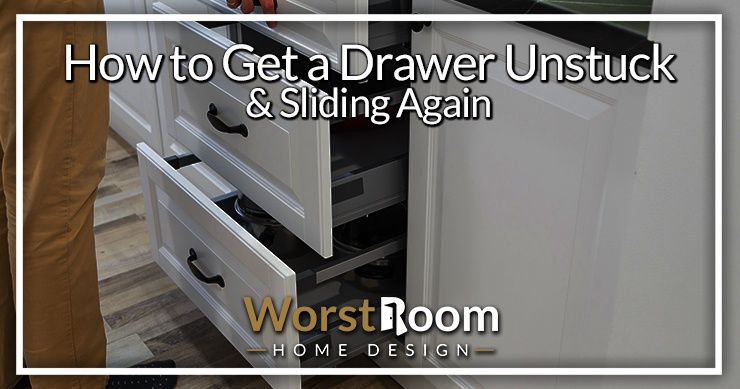
Is the kitchen drawer stuck again? What a hassle. Stuck drawers are challenging to open and close and cause a headache for anyone. Trying to jiggle the drawer open is enough to test anyone's boiling point. We put together this brief guide to give you pragmatic strategies on how to get a drawer unstuck.
What Are the Reasons Drawers Stick?
There’s a handful of reasons most types of drawers get stuck either open or in a closed position. Let’s describe each one and then provide a solution.
Bent or Misaligned Track
With a bump while the drawer is open or just over time, you can get a bent track or misalignment in bottom-mounted drawers. This is the track where the drawer wheels roll in. Sometimes the wheels can even hop out of the track altogether, which will really bind things up.
The solution to fixing this is to use pliers to bend them back into shape. It may not come out perfect but they’ll at least be in good enough shape to be usable again.
Uneven or Rough Spots in the Track or Wheels
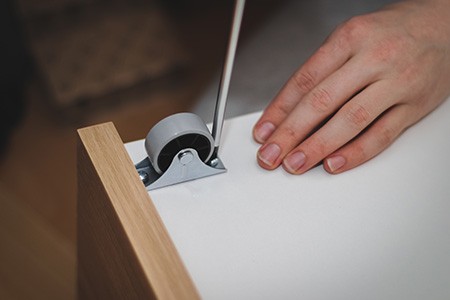
Occasionally something can end up inside the track, causing the wheels to rub instead of roll. You see this same thing in grocery store buggies. The wheels become unable to spin and drag, causing a flat spot to appear on the wheel. This can happen to the track too, causing bumps or dips.
What you can do about it is sand the tracks or the wheels to return them to their original smooth status. You may end up with a wheel that’s a bit smaller than it should be, but with proper lubrication it will roll like it should.
Debris & Dust in the Tracks
Over time, food crumbs, dust, and other items can accumulate in the tracks. This can create a problem similar to the one above where the wheels can’t spin any more, which can lead the drawer to jam itself sideways.
The solution here is to vacuum, blow, or wipe away the debris. You essentially just need the tracks cleaned and smooth. Don’t add a bunch of lubrication in the track because it’ll form a thick goo as dust ends up in there again. You can lubricate the wheels, though.
Loose Drawer Slides & Loose Screws
Many drawers will have slides that are a track that is seated within another track, which extends outwards to allow and support the drawer to extend further. Loose slides occur due to loose screws holding the slides in place. To fix this, simply tighten the screws and slides and hope they didn’t get all bent out of shape.
Slides & Screws Are Too Tight
Tight slide components created excessive friction when opening the drawer. This can cause everything to bind up, bend, create rough spots on wheels and tracks, etc. To fix this, check the screws and possibly loosen them a small amount, and then lubricate the slides.
Damage to Side-Mount Soft-Close Sliders
Damage can occur to the side-mount soft-close sliders. These are going to be more complex than you’ll want to deal with (unless you’ve got the time and are real handy). The best move is to simply order replacement parts and swap them out rather than trying to figure out how to get a drawer unstuck with these types of slides.
What Lubricants Are the Best for Unsticking Drawers?
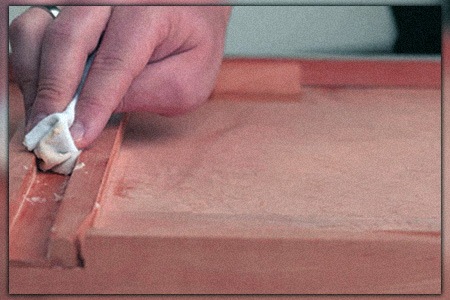
Sometimes, all it takes to loosen a sticking drawer is a quick squirt of lubricant. It's also a good idea to lubricate the slides before the seasons change to ensure smooth operation when humidity increases. Refrain from using petroleum or oil-based lubricants, as they attract dirt and grime, worsening the problem. We recommend using graphite, silicone, and Teflon-based lubricants for the job.
Silicone-Based Lubricants
Silicone lubricants are a great choice for stuck slides, especially those exposed to moisture that has the propensity to rust. It's a water-resistant lubricant that's long-lasting and doesn't degrade over time.
Teflon-Based Lubricants
Teflon, or "PTFE" lubricants (meaning Polytetrafluoroethylene), are called "dry lubricants" because they don't drip or run after application. They create a friction-free surface, making it easy to open and close the drawer without it sticking. These lubricants are slightly more expensive than silicone types.
Graphite-Based Lubricants
This is another dry lubricant relying on powdered graphite to create a friction-free surface on slides. They last a long time compared to the other options.
Tips for Removing Stuck Drawers
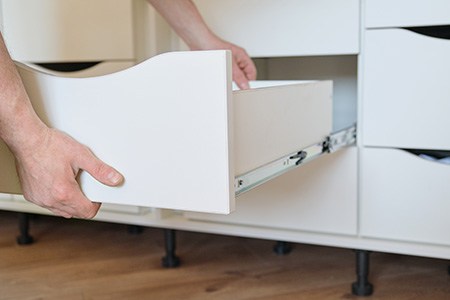
Before you start the task of trying to unstick the drawer, gather the following materials and tools:
- Philips head screwdriver
- Pliers
- Vacuum cleaner & attachments
- Some type of bucket or container
- Microfiber cloth
- Can of teflon, graphite, or silicone lubricant
- Dish soap
- 200-grit sandpaper
- Replacement drawer slides where necessary
You need to remove the stuck drawer from the cabinet before fixing it. Most kitchen-mounted drawers feature a hidden release mechanism such as a latch, clip, lever, or button you press to release the drawer from the slides. Follow these instructions to remove the drawer:
- Fully open the drawer to access the slides.
- Find the release mechanism. It's usually toward the back of the track.
- Flip the lever or press the release button.
- Pull out the drawer and remove it from the slides.
- Old-style bottom-mount drawer slides require you to pull out the drawer and lift it up to remove it from the slides.
Take your time looking in, under, and reaching around feeling the slides and tracks of the drawer. You’ll figure out how to get it out. If you get stuck, try lifting up on it once you’ve pulled the drawer out. There may not be any release mechanism.
Methods for Making Drawers Slide Easy
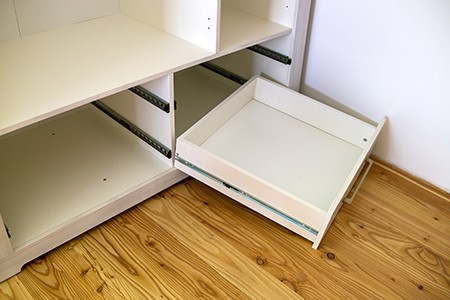
We don’t want to simply unstick (or get unstuck) the drawer. We want it to operate properly, rolling in and out smoothly. Here’s how to get a drawer unstuck and sliding easily again.
Clean the Tracks
Start with cleaning the tracks. It's common for the tracks to accumulate dust and grime over time (especially in the kitchen). These foreign bodies create more friction when opening and closing the drawer, leading to the sticking problem.
Use your vacuum cleaner with the crevice attachment to vacuum the loose debris and wipe the rest away with a microfiber cloth. If you have any grime stuck to the tracks, wash it with a mild dish soap and water solution. Ensure it's completely dry before returning the drawer to the slides, or it will rust and cause more sticking problems.
Lubricate the Tracks
If you have a stuck drawer, releasing it could be as simple as squirting some lubricant onto the tracks and running the drawer back and forth a few times to work the lubricant into the slides. Lubricating the tracks and slides helps to remove the friction causing the problem.
Removing the drawer when you get it unstuck and inspecting the tracks is always a good idea. If they look dirty, follow the previous steps to clean the slides and tracks before lubricating again and returning the drawer. Don't use WD-40 to lubricate stuck drawers. Oil-based lubricants attract more dirt, resulting in them sticking again in a few months.
Tighten the Slide Screws
The crew holding the drawer in position may loosen over time, causing friction that makes the drawer stick when opening or closing. You'll need to remove the drawer and tighten the screws. Most screws have Phillip's heads, so keep that screwdriver handy.
Don't use an electric screwdriver for the task. It's easy to over-tighten or strip the screws, making it hard for the sliders to work smoothly. Use a manual screwdriver for the job.
Adjust the Slides
The bottom-mount drawer slides might be bent or misaligned, causing the sticking issue. Use your screwdriver to correct any misalignment, or turn the tracks back into the correct position using pliers. Refit the drawer and test it to see if it improves. Remember to clean and lubricate the slides and tracks before finishing the job.
Replace the Slides
Everything has a service life, even the slides and tracks on kitchen drawers. If you have an old kitchen drawer, you might have to replace the hardware to solve the problem. In this case, you'll need a replacement set of slides and tracks from the manufacturer. If you don't know the manufacturer, take the slides and tracks to the local hardware store and ask the attendant for a replacement set.
After removing the drawer from the slides, measure it from the back of the front of the drawer to the back of the drawer. Or just take the slides or the drawer with you to the hardware store. You'll need to note the position of the slides before replacing them, or you'll refit the new slides improperly, leading to a stuck drawer.
Unlatch and separate the halves of each slide on the drawer and use your screwdriver to remove the screws holding the old slides in position and remove the old components. You have to do this on the cabinet and the drawer. Screw the other halves of your new slides onto the drawer and slide it back in place after assembly.
You should hear a click when you push the drawer into the closed position. If your drawers have bottom-mounted slides, upgrade them to newer-model soft-closing slides.
Sand Sticking Spots
If you have a wooden dresser drawer stuck due to swelling in humid conditions or rough spots on the tracks or drawer, sand down the high areas, and the drawer should move smoothly back and forth. Most wooden bedroom furniture, such as dressing tables and clothes cabinets, have wooden drawers.
Remove the drawer. Locate the areas that rub against each other by looking for scratched or worn spots on the wood. Sand these areas lightly with your 200-grit sandpaper. Refrain from over-sanding, as the drawer will feel loose when opening and closing it. You can always go back and sand it some more if it still sticks.
When You Need Professional Assistance
Sometimes you can't remove the drawer no matter what you do. Don't get mad; call a professional. A handyman in your area should have plenty of experience with the problem, and they won't charge you much to fix the drawer. Plus, they can deal with tasks like replacing the slides or planning wooden drawers if you don't have any handy experience.
FAQ’s For How to Open a Stuck Drawer
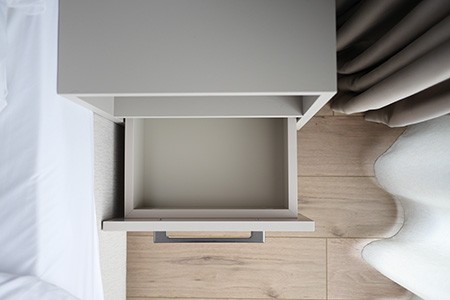
When we start thinking about how to unjam a drawer, there’s a lot of other questions that start to arise. Let’s deal with those now, all related to how to get a drawer unstuck and sliding well again.
How Do You Remove a Stuck Drawer With No Release?
If the drawer has no button or locking lever, try to wiggle the drawer forward. Lift it upward until you hear a click. This action removes the button slides allowing you to pull the drawer out.
Why Can't I Get the Drawer Unstuck?
Examine the drawer guides and look for a locking lever or clip. If there's a lever, remove it and push the lever while pulling out the drawer. If there's a clip, remove it and pull out the drawer.
Why Does a Dresser Drawer Get Stuck?
Wooden dresser drawers get stuck because of excess humidity in the air causing the wood to swell. Get the drawer moving freely again by removing it and planing the sides of the drawer to allow free movement. This requires woodworking tools and skills and will be necessary to fix your wooden types of dressers if they encounter this issue.
Key Takeaways for How to Open a Drawer That is Stuck
Let’s recap the main points above in a quick summary to explain how to open stuck drawers and why it happens.
- Drawers stick for several reasons. In the kitchen, it probably has something to do with the slides and tracks the drawers run on when opening or closing.
- The most common reasons for stuck kitchen drawers include the build-up of dirt and debris, old tracks and slides, or bent or misaligned tracks and slides.
- Don't use oil-based lubricants when lubricating drawers; they attract more dirt and grime. Stick with silicone, graphite, or PTFE lubricants.
- If you have to replace the slides and tracks, take them with you to the hardware store to get the right replacement set.
- Wooden drawers in bedroom furniture might require light sanding to get them to move freely again.
And that’s how to unstick a drawer! You need to determine what kind of drawer you’re working with, figure out how to pull it out completely, and then figure out what the problem is. Then you can fix it, lubricate it, and put the drawer back together.
That’s How to Get a Drawer Unstuck
If you get over the frustration of the whole ordeal, slow down, and go through the steps outlined above, you’ll be able to unstick the drawer for now, remove it, fix the problem, and restore it to proper working conditions fairly easily. It’s not a huge project either, thankfully. My friends, that’s how to get a drawer unstuck. Try to have fun with it.



